Affiliate links on Android Authority may earn us a commission. Learn more.
A beginner's guide to video chat
Published onSeptember 30, 2016
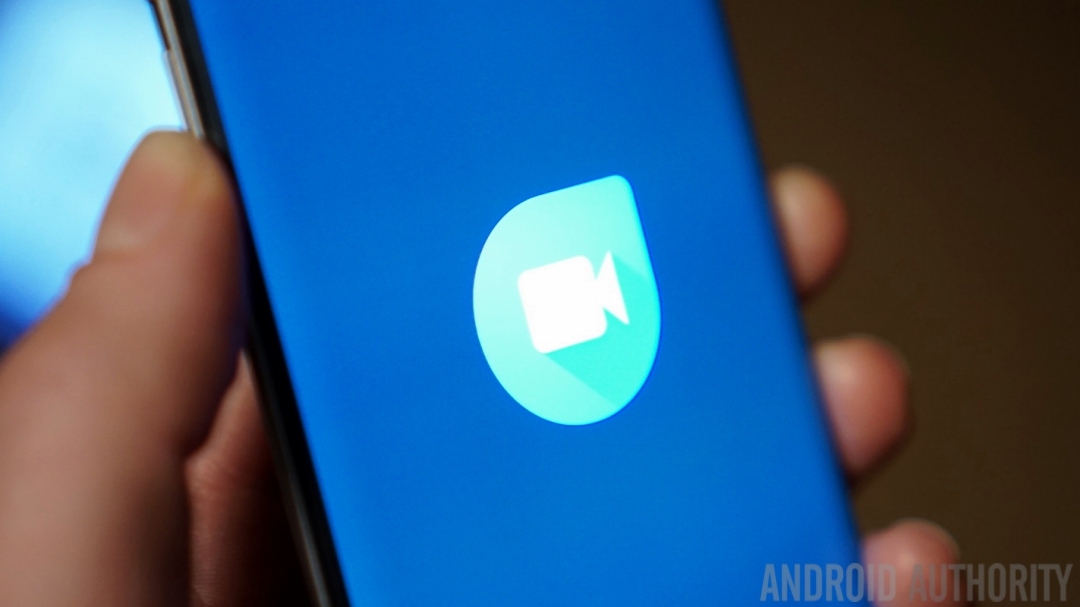
It finally happened: With a few quick swipes and taps, our mobile devices become conduits of live two-way video through which we can speak face-to-face with family members, significant others, friends, colleagues, and acquaintances. Video chat is no longer science fiction and can be part of our daily communications. However, it seems that only a relative few are actually using this game-changing technology,
According to a study from last fall, about 68 percent of all American adults own a smartphone, which is roughly two in three American adults. Of those people, less than half (47 percent) have ever used video chat platforms on their smartphones, and this represents a sharp increase from 33 percent in 2013 and 19 percent in 2011. Obviously, there are more and more people using video chat on their smartphones. On the other hand, with several capable video chat platforms from which to choose, why are only a minority of smartphone users using them?
One reason could be that it can sometimes be difficult to have off-the-cuff video chats in the same way we make phone calls. It’s one thing to jump out of the shower to take an important phone call and another matter to video chat with someone while wearing only a towel. Video chat requires more foresight and preparation than is necessary for phone calls. Or perhaps you’re of the opinion that video chat seems more complicated than it’s worth. If that’s the case, fear not. We have you covered.
If the release of Google Duo tells us anything, it’s that video chat is as relevant as ever and will likely hold a prominent place in mobile communication as we move forward. Whether you’re simply a late adopter or haven’t gotten around to learning how the whole “video chat thing” works, the following is a concise guide to the art of the video chat using four of the most popular and easy-to-use platforms: Google Duo, Google Hangouts, Skype, and Facebook Messenger.
Google Duo
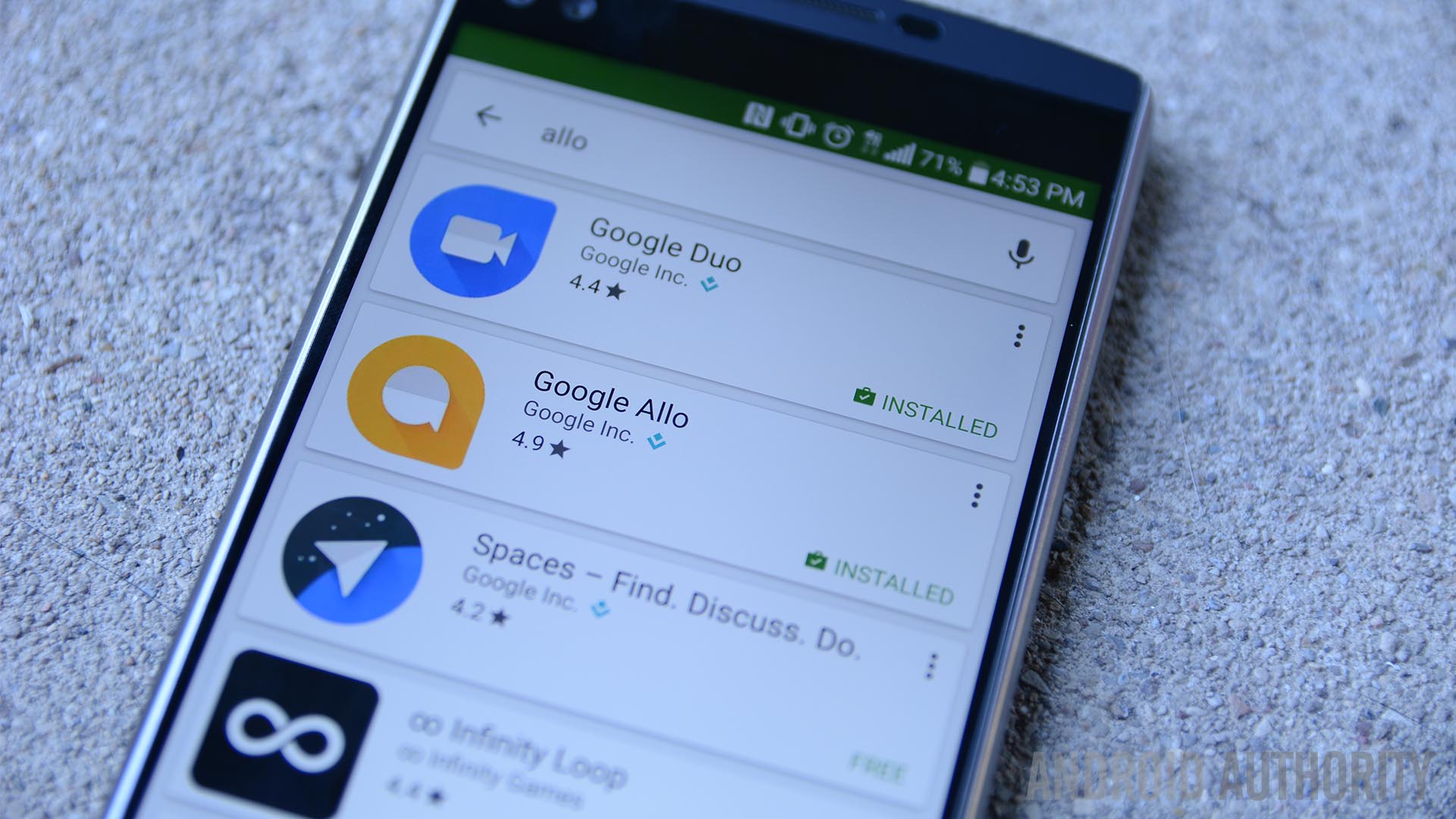
It’s no surprise that some of the best video chat platforms for Android users are the ones that were actually made by Google, with the first in our guide being Duo. Google Duo is the latest video chat platform for Android and Google seems to be banking on it becoming the Android equivalent of Apple’s FaceTime for iOS. However, the key difference (and what should be a major advantage, but that’s another story) between Duo and FaceTime is that the former supports both Android and iOS. This means if your friends download Duo, you’ll be able to video chat with all of them no matter who carries an iPhone and who carries an Android. (Apologies to the dozen or so Windows Phone users out there who are feeling left out.)
How to start using Google Duo for video chat
- Setup your Google Duo account: First, download the Google Dup app from the Play Store and complete the painless setup process. It will ask for your cell number so it can send a verification code via text, which allows Duo to link your cell number to your Google Duo account. The app recognizes anyone who’s signed up for Duo using phone numbers stored in a device’s contacts list. By verifying and linking your cell number to your account, your friends will be able to see that you’re available for Duo video chats.
- Open Duo and begin initiating a video chat: When you open Duo, you’ll notice the app immediately activates your front-facing camera, showing you a live image of yourself with a “Video call” button underneath. Click that button.
- Choose someone for a video chat: At this point, you will see an in-app list of your contacts. Any contacts who are already using Duo will appear at the very top of the list, followed by the remainder of your contacts, each with their own “invite” button so you can invite them to use Duo. Begin your video chat by clicking on the name of the Duo user of your choice. Duo will begin to call that person in much the same way as a regular phone call. As long as your recipient has a WiFi or LTE connection, he or she will be prompted to answer or decline your “video call”.
Something else that should be mentioned here is a feature called “Knock Knock”. Instead of seeing the photo that’s associated with your contact information, Knock Knock lets the person whom you are calling actually see you via your front-facing camera before he or she answers the call. It’s a bit of an odd feature that has brought up issues concerning privacy, but you have the option to turn off Knock Knock in the settings. If you have Knock Knock turned on, make sure you’re actually ready for your video chat before you begin initiating the connection.
Google Hangouts
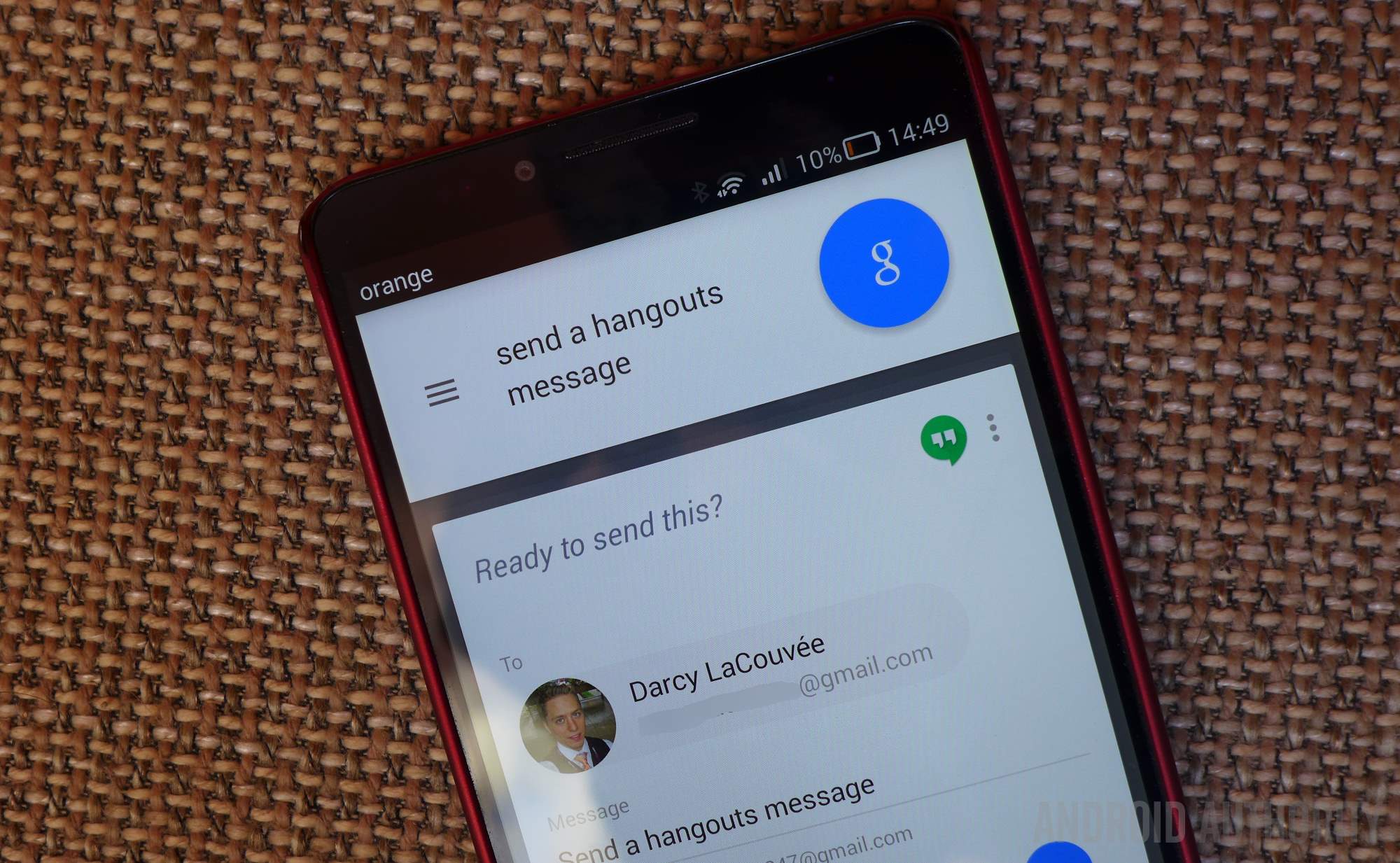
For those of us who prefer the simple, unadulterated predictability of Google services, Hangouts is typically the preferred means of conducting video chats. Granted, many of us will go off and explore new services and platforms on occasion, but we routinely return to Hangouts because it’s simple and reliable. If Duo is the new kid on the block who’s trying to make friends, Hangouts is that dude who comes home from college to throw great parties throughout the summers and during the holidays.
Unlike Duo, Hangouts isn’t just for video chat. When it was unveiled in mid-2013, Google Hangouts — which took its name from the popular Hangouts video chat feature of Google+ — was multifunctional, proprietary communications platform for instant messaging, voice calls, and video chat. In short order, SMS integration was added to Hangouts, but more recently was ported off Hangouts and into its own separate application called Messages. Today, there seems to be a dichotomy among Hangouts users: people who use Hangouts for instant messaging (typically a business scenario) and people who use Hangouts for video chat.
Getting started with video chat on Google Hangouts
- Sign up for Hangouts: Chances are you’ve already signed up for Hangouts and used it for one reason or another. It doesn’t require a cell phone number and comes pre-installed on virtually all Android phones, so all it takes to start using it is to be signed into your Google account.
- Begin initiating a video chat: Open Hangouts and click the “+” button in the bottom-right corner. This will give you three different options: start an instant messaging session with one person, with a group of people, or to start a video chat. Choose the video chat option.
- Find someone for a video chat: At this point, you’ll see a list of your contacts. The people currently using Hangouts and, therefore, are ready to video chat will have quotation marks stamped on the edge of their profile pictures. As well, the words “On Hangouts” will appear next to their names. Click on the person with whom you want to video chat and Hangouts will start to call that person in much the same way as a normal phone call.
Skype
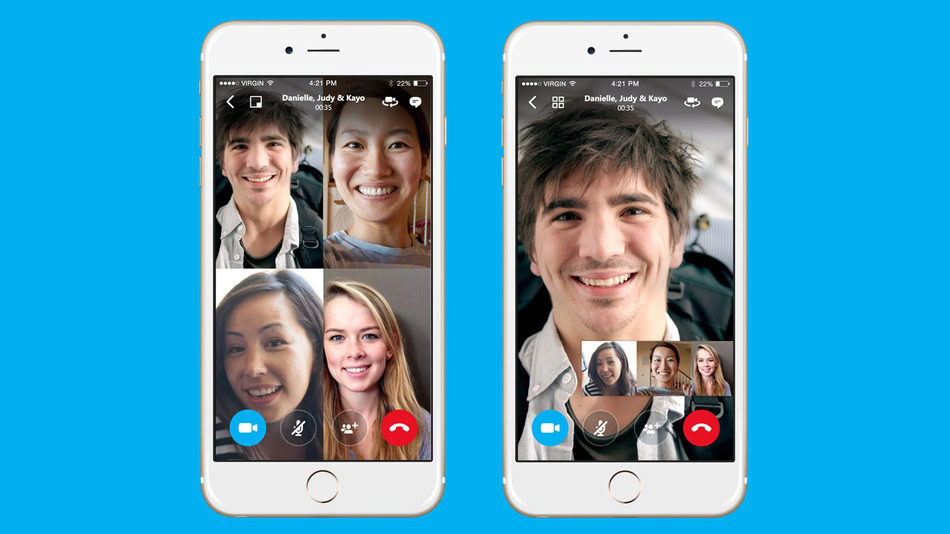
Although most Android users are intimately acquainted with Hangouts, Skype tends to be the most widely-recognized option and there’s surely no platform that’s as strongly associated with video chat as Skype. Part of this is due to Skype being available on basically every mobile and desktop operating system that exists. But it has been around for the longest, too, with Skype having made its debut in 2003. Other services come and go, but Skype remains a favorite among video chat users, especially those who chat regularly with people in other countries.
Start Skyping in three easy steps
- Download Skype app and create an account: First, you’ll need to download the Skype app from the Play Store on your Android smartphone. Upon opening Skype for the first time, you’ll be prompted to log in or create an account; choose the latter option. You’ll be required to provide either your phone number or your email address so that other Skype users can find you and engage in video chats, voice calls, and instant messaging.
- Find someone for a Skype video chat: Once you’ve signed up and successfully logged into the Skype app, you’ll be greeted by the main screen with three separate tabs at the top; choose the center tab, which is for your contacts. Here you’ll see all the contacts you have stored on your phone. Those who aren’t using Skype will have “Invite” buttons located beside their names while those that are using Skype will have a blank space there instead. Click on the user with whom you want to Skype, which will bring up a thread where you and that person can exchange instant messages.
- Initiate a Skype video chat: Near the top of the screen by the recipient’s name, you’ll see a video camera icon. Simply click that video camera icon to begin “calling” that person for a video chat. If that person is using a device on which Skype is installed and has some type of internet connection, he or she will be able to accept.
Facebook Messenger
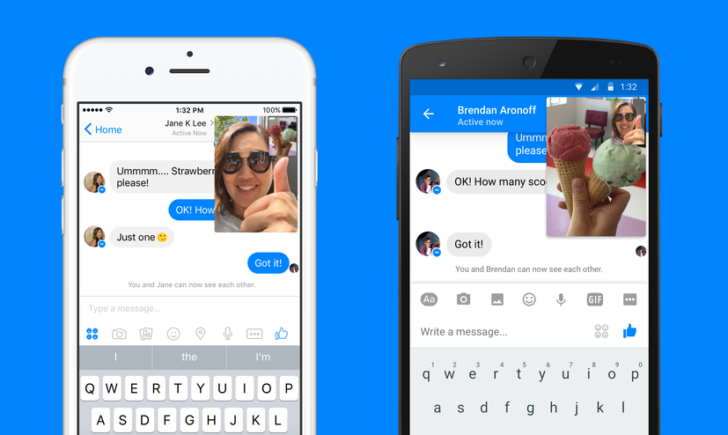
If there’s any company that could be said to rival Google in terms of its prominence in our daily lives, it’s definitely Facebook. It may no longer be at the forefront of the social media hype train like it was just a couple years ago, but it’s still the biggest social network there is. If you’re skeptical, consider these figures: Earlier this year, it was found that Facebook has 1.59 billion users who are active at least throughout the month.
Let that sink in for a moment. In 2013, the whole world’s population was 7.125 billion people; if that figure is similar today, over 22 percent of the global population uses Facebook regularly; keep in mind this number includes only active users, which, looking just at the U.S., is nearly 75 percent of all American adults who are online. By comparison, Facebook-owned Instagram has 400 million active users while Twitter has 320 million active users.
In providing these statistics, I hope your takeaway from this is that there’s a pretty significant chunk of the population using Facebook, which has been steadily expanding its wheelhouse, building out its social network into something more. Case in point: Facebook Messenger. It used to be that you could exchange Facebook messages within the actual Facebook app; however, following the launch of the separate messaging app in 2011, Facebook Messenger soon became the only way to exchange Facebook messages between mobile devices. More recently, SMS integration, voice calls, and video chat has been incorporated into Facebook Messenger. Since most of your family members and friends are probably using Facebook, this may be the most convenient option when it comes to using video chat since it won’t require anyone to sign up for new and unfamiliar services.
Using Facebook Messenger for video chat
- Download and sign into Facebook Messenger: You probably already have Facebook Messenger set up; however, if you’ve not yet used it, download Facebook Messenger from the Play Store. Open the app and either sign into your Facebook account or follow the prompts to create a new one. It will ask for your cell number, which is optional; providing your cell number will allow people with whom you’re not Facebook friends but who have your cell number saved in their phones to contact you via Facebook Messenger.
- Find someone for a video chat: After logging into Facebook Messenger, you’ll be taken to the main screen where you’ll see any messages you’ve exchanged with Facebook friends in the past. If you have “favorited” any of your friends, you’ll likely see a special section for your favorite contacts here, too. If you don’t see anyone with whom you want to video chat, look to the tabs running along the top of the screen and choose the icon that looks like a telephone. This will take you to a list of your contacts who are ready and able to receive voice calls and video chats.
- Initiate the video chat: Once you’ve found the person with whom you want to video chat, it’s as simple as pressing the corresponding button. Beside each person on the list, you’ll see two icons, a telephone and a video camera. Press the video camera and Facebook Messenger will begin to “call” the recipient much like a regular phone call. Be aware that while you wait for an answer, the call will be minimized to a small window at the top-right corner of the screen, allowing you to continue using your device while you wait for your recipient to answer.
This concludes our lesson for today, and I want to hear from you. Now that you’re a bonafide video chat expert, does it seem like something you will or would like to use? Were you already using video chat? Sound off in the comment section below and make sure to share this video chat guide with anyone who might be having trouble adopting this relatively newfangled, easier-than-it-looks technology. And as always, keep it tuned to Android Authority as we continue to be your go-to source for all things Android.